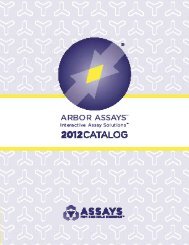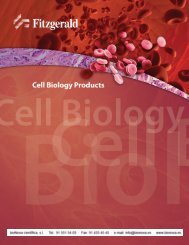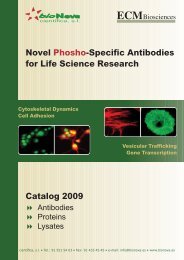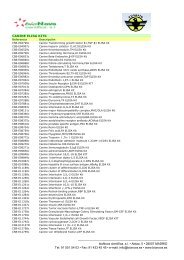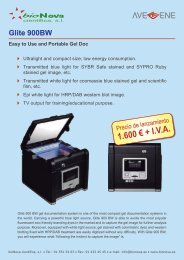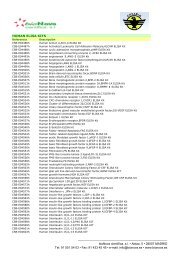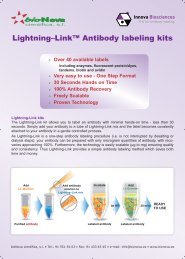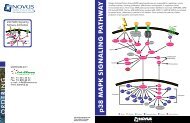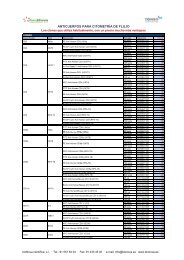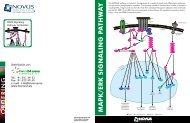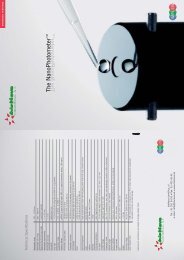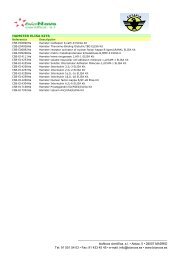Expresso™ T7 SUMO Cloning and Expression System
Expresso™ T7 SUMO Cloning and Expression System
Expresso™ T7 SUMO Cloning and Expression System
Create successful ePaper yourself
Turn your PDF publications into a flip-book with our unique Google optimized e-Paper software.
Expresso <strong>T7</strong> <strong>SUMO</strong> <strong>Cloning</strong><br />
<strong>and</strong> <strong>Expression</strong> <strong>System</strong><br />
IMPORTANT!<br />
-80C <strong>and</strong> -20C Storage Required<br />
Immediately Upon Receipt<br />
Lucigen ®<br />
Corporation<br />
Advanced Products for Molecular Biology<br />
2120 W. Greenview Drive<br />
Middleton, WI 53562<br />
Toll Free (888) 575-9695<br />
Phone (608) 831-9011<br />
FAX (608) 831-9012<br />
Email lucigen@lucigen.com<br />
www.lucigen.com<br />
FOR RESEARCH USE ONLY. NOT FOR HUMAN OR DIAGNOSTIC USE<br />
MA108 v1.0
Expresso <strong>T7</strong> <strong>SUMO</strong> <strong>Cloning</strong> <strong>and</strong> <strong>Expression</strong> <strong>System</strong><br />
Technical Support<br />
Lucigen is dedicated to the success <strong>and</strong> satisfaction of our customers. Our products are tested to<br />
assure they perform as specified when used according to our recommendations. It is critical that the<br />
reagents supplied by the user, especially the DNA targets to be cloned, are of the highest quality.<br />
Please follow the manual carefully or contact our technical service representatives for information on<br />
preparation <strong>and</strong> testing of the target DNA. We encourage you to contact us with your comments<br />
regarding the performance of our products in your applications. Thank you.<br />
Notice of Limited Label License, Copyright, Patents, Warranties, Disclaimers <strong>and</strong><br />
Trademarks<br />
Copyright 2010 by Lucigen Corp. All rights reserved. Lucigen, BigEasy, ClonePlex, CloneSmart, CopyRight,<br />
DNATerminator, E. cloni, EconoTaq, NanoClone, PCR Terminator, pJAZZ, pSMART, pTrueBlue, <strong>and</strong> PyroPhage are<br />
registered trademarks of Lucigen Corporation. bSMART, CloneDirect, cSMART, Expresso, eLucidations, GapFree,<br />
HI-Control, PCR SMART, pETite, pEZ, pEZSeq, pGC, pLEXX-AK, pRANGER, PyroScript, Replicator,<br />
Transformance, TSA, <strong>and</strong> UltraClone are trademarks of Lucigen Corporation. OverExpress is a trademark of Imaxio,<br />
S.A.<br />
Lucigen’s products are sold for research use only <strong>and</strong> are not to be used in humans or for medical diagnostics.<br />
Lucigen’s liability with respect to any Expresso product is limited to the replacement of the product. No other<br />
warranties of any kind, expressed or implied, including without limitation, any implied fitness for any particular use,<br />
are provided by Lucigen. Lucigen is not liable for any direct, indirect, incidental or consequential damages arising out<br />
of or in connection with the use or inability to use any of its Expresso products.<br />
Coomassie is a registered trademark of Imperial Chemical Industries, plc. HIS-Select is a registered trademark of<br />
Sigma-Aldrich Biotechnology LP <strong>and</strong> Sigma-Aldrich Co. Phusion is a registered trademark of Finnzymes Oy. TALON<br />
is a registered trademark of Clontech Laboratories, Inc. Triton is a registered trademark of Union Carbide Chemicals<br />
<strong>and</strong> Plastics Company, Inc.<br />
Limited Label License<br />
This product is the subject of U.S. Patent #6,709,861 <strong>and</strong> additional patent applications owned by Lucigen<br />
Corporation are pending. The consideration paid for this product grants a Limited License to use the product pursuant<br />
to the terms set forth in this Limited Label License. Academic, Not-for-Profit <strong>and</strong> For-Profit institutions acquire certain<br />
limited nontransferable rights with the purchase of this product (see below).<br />
The purchase price of this product includes limited, nontransferable rights to use only the purchased amount of the<br />
product. This limited license specifically excludes manufacture of the pETite vectors or derivatives thereof. Lucigen<br />
Corporation reserves all other rights; in particular, the purchaser of this product may not transfer or otherwise sell this<br />
product or its components or derivatives to a third party, <strong>and</strong> no rights are conveyed to the purchaser to use the<br />
product or its components or derivatives for commercial purposes. “Commercial purposes” includes any activity for<br />
which a party receives consideration <strong>and</strong> may include, but is not limited to, (1) use of the product or its components or<br />
derivatives in manufacturing, (2) use of the product or its components or derivatives for diagnostic purposes, (3)<br />
transfer or sale of vectors made with the product or components or derivatives of the product, (4) use of this product<br />
or materials made therefrom to provide a service, information, or data (e.g., DNA sequence) to a third party in return<br />
for a fee or other consideration, or (5) resale of the product or its components or derivatives, whether or not such<br />
product or its components or derivatives are resold for use in research. Academic, Not-for-Profit, <strong>and</strong> For-Profit<br />
institutions must obtain a separate license from Lucigen Corporation to use this product for any purpose other than<br />
those permitted above. It is the sole responsibility of the buyer to ensure that use of the product does not infringe that<br />
patent rights of third parties.<br />
The 6xHis tag is licensed from Hoffmann-La Roche, Inc., Nutley, NJ <strong>and</strong>/or Hoffmann-LaRoche Ltd., Basel,<br />
Switzerl<strong>and</strong> <strong>and</strong> is provided only for the use in research. Information about licenses for commercial use is available<br />
from QIAGEN GmbH, QIAGEN Strasse 1, D-40724 Hilden, Germany. Purification of 6xHis tagged proteins with Ni-<br />
NTA manufactured by QIAGEN is highly recommended for best performances <strong>and</strong> to avoid poor purification results.<br />
<strong>SUMO</strong> Express Protease is manufactured <strong>and</strong> supplied by LifeSensors, Inc.<br />
HI-Control BL21(DE3) products are sold under a license issued to Lucigen Corporation by Brookhaven Science<br />
Associates, LLC for noncommercial research purposes only. A separate license is required for any commercial use,<br />
including the use of these materials for research purposes or production purposes by any commercial entity.<br />
Information about commercial licenses may be obtained from the Office of Technology Commercialization <strong>and</strong><br />
Partnership, Brookhaven National Laboratory, Bldg. 490-C, P. O. Box 5000, Upton, New York 11973-5000, telephone<br />
Lucigen ® Corporation 2<br />
(888) 575-9695 MA108 V1.0 www.lucigen.com
Expresso <strong>T7</strong> <strong>SUMO</strong> <strong>Cloning</strong> <strong>and</strong> <strong>Expression</strong> <strong>System</strong><br />
(631)-344-7134. In using this product, you agree that HI-Control BL21(DE3) cells or derivatives containing the cloned<br />
gene for <strong>T7</strong> RNA Polymerase may not be distributed further to third parties outside of your laboratory, unless the<br />
recipient receives a copy of this limited label license <strong>and</strong> agrees to be bound by its terms.<br />
If the purchaser is not willing to accept these use limitations, Lucigen Corporation is willing to accept return of the<br />
product for a full refund. For information on obtaining a license, contact Lucigen Corporation, 2120 W. Greenview Dr.,<br />
Middleton, WI 53562. Email: Lucigen@lucigen.com. Phone: 608-831-9011. Fax 608-831-9012.<br />
Lucigen ® Corporation 3<br />
(888) 575-9695 MA108 V1.0 www.lucigen.com
Expresso <strong>T7</strong> <strong>SUMO</strong> <strong>Cloning</strong> <strong>and</strong> <strong>Expression</strong> <strong>System</strong><br />
Table of Contents<br />
<strong>System</strong> Designations .......................................................................................................................... 5<br />
Components & Storage Conditions ..................................................................................................... 5<br />
<strong>System</strong> Description ............................................................................................................................. 6<br />
pETite N-His <strong>SUMO</strong> Kan Vector ......................................................................................................... 8<br />
HI-Control 10G Chemically Competent Cells ...................................................................................... 8<br />
HI-Control BL21(DE3) cells................................................................................................................. 9<br />
<strong>Cloning</strong> Strategy.................................................................................................................................. 9<br />
Positive Control Insert ....................................................................................................................... 10<br />
Colony Screening.............................................................................................................................. 10<br />
Protein <strong>Expression</strong> ............................................................................................................................ 10<br />
Protein Purification ............................................................................................................................ 11<br />
<strong>SUMO</strong> Express Protease .................................................................................................................. 11<br />
<strong>SUMO</strong> Cleavage Control Protein ...................................................................................................... 11<br />
Materials <strong>and</strong> Equipment Needed ..................................................................................................... 11<br />
Detailed Protocol............................................................................................................................... 12<br />
Preparation of Insert DNA ................................................................................................................. 12<br />
Primer Design for Target Gene Amplification.................................................................................... 12<br />
Amplification of Target Gene............................................................................................................. 13<br />
Enzyme-Free <strong>Cloning</strong> with pETite Vectors........................................................................................ 14<br />
Transformation of HI-Control 10G Chemically Competent Cells ....................................................... 15<br />
Colony PCR Screening Recombinants ............................................................................................. 16<br />
DNA Purification & Sequencing......................................................................................................... 16<br />
Transformation into HI-Control BL21(DE3) Chemically Competent Cells ......................................... 17<br />
Induction of Protein <strong>Expression</strong>......................................................................................................... 18<br />
SDS-PAGE Analysis ......................................................................................................................... 18<br />
Affinity Purification of 6xHis tagged proteins ..................................................................................... 18<br />
Removal of <strong>SUMO</strong> tag by <strong>SUMO</strong> Express Protease......................................................................... 18<br />
References........................................................................................................................................ 20<br />
Appendix A: Media Recipes .............................................................................................................. 21<br />
Appendix B: Vector Map <strong>and</strong> Sequencing Primers ........................................................................... 22<br />
Appendix C: <strong>Cloning</strong> Troubleshooting Guide .................................................................................... 23<br />
Appendix D: <strong>Expression</strong>/Purification Troubleshooting Guide ............................................................ 24<br />
Appendix E: Protease Digestion Troubleshooting Guide .................................................................. 25<br />
Appendix F: Sequence of pETite N-His <strong>SUMO</strong> Vector...................................................................... 26<br />
Lucigen ® Corporation 4<br />
(888) 575-9695 MA108 V1.0 www.lucigen.com
Expresso <strong>T7</strong> <strong>SUMO</strong> <strong>Cloning</strong> <strong>and</strong> <strong>Expression</strong> <strong>System</strong><br />
<strong>System</strong> Designations<br />
The Expresso <strong>T7</strong> <strong>SUMO</strong> <strong>Cloning</strong> <strong>and</strong> Protein <strong>Expression</strong> <strong>System</strong> contains pre-processed pETite N-His<br />
<strong>SUMO</strong> Vector DNA, HI-Control 10G Chemically Competent Cells for cloning, HI-Control BL21(DE3)<br />
Chemically Competent Cells for protein expression, <strong>and</strong> <strong>SUMO</strong> Express Protease. The <strong>System</strong> catalog<br />
numbers are listed below.<br />
Expresso <strong>T7</strong> <strong>SUMO</strong><strong>Cloning</strong> <strong>and</strong> <strong>Expression</strong> Kits<br />
5 Reactions 10 Reactions<br />
Expresso <strong>T7</strong> <strong>SUMO</strong> <strong>Cloning</strong> <strong>and</strong> <strong>Expression</strong> <strong>System</strong> 49003-1 49003-2<br />
Components & Storage Conditions<br />
The Expresso <strong>T7</strong> <strong>SUMO</strong> <strong>Cloning</strong> <strong>and</strong> <strong>Expression</strong> <strong>System</strong> consists of four separate containers. Container<br />
1 includes the pETite <strong>SUMO</strong> <strong>Expression</strong> Vector, <strong>SUMO</strong> Positive Control Insert DNA, <strong>and</strong> DNA primers for<br />
screening inserts by PCR <strong>and</strong> sequencing. This container should be stored at -20 o C. Container 2<br />
contains <strong>SUMO</strong> Express Protease <strong>and</strong> <strong>SUMO</strong> Cleavage Control Protein, <strong>and</strong> should be stored at -80°C.<br />
Container 3 includes HI-Control 10G Chemically Competent Cells, which must be stored at -80°C.<br />
Container 4 contains HI-Control BL21(DE3) Chemically Competent Cells, which must be stored at -80 o C.<br />
The 10-reaction Kits are supplied with two of container 1 <strong>and</strong> two of container 2.<br />
Expresso <strong>T7</strong> <strong>SUMO</strong> <strong>Cloning</strong> Kit Container Store at -20°C<br />
Concentration Volume<br />
pETite N-His <strong>SUMO</strong> Kan Vector DNA (5 reactions) 12.5 ng/l 15l<br />
<strong>SUMO</strong> Positive Control C Insert DNA 50 ng/l 10 l<br />
Primers for PCR screening <strong>and</strong> sequencing<br />
<strong>SUMO</strong> Forward Primer<br />
pETite Reverse Primer<br />
50 pmol/l<br />
50 pmol/l<br />
100 l<br />
100 l<br />
<strong>SUMO</strong> Express Protease Container Store at -80°C<br />
Concentration Amount<br />
<strong>SUMO</strong> Express Protease 1 unit/l 50 units<br />
<strong>SUMO</strong> Cleavage Control Protein 2 µg/l 50 g<br />
HI-Control 10G Chemically Competent Cells Container Store at -80C<br />
Cap Color 5 Reaction Kit 10 Reaction Kit<br />
HI-Control 10G Chemically Competent Cells White 6 x 40 l 12 x 40 l<br />
Transformation Control pUC19 DNA (10 pg/l) 20 l 20 l<br />
Recovery Medium (Store at -20C or -80C) 1 x 12 ml) 1 x 12 ml)<br />
HI-Control BL21(DE3) Chemically Competent Cells Container Store at -80C<br />
Cap Color 5 Reaction Kit 10 Reaction Kit<br />
HI-Control BL21(DE3) Chemically Competent<br />
Cells<br />
Gray 6 x 40 l 12 x 40 l<br />
Transformation Control pUC19 DNA (10 pg/l) 20 l 20 l<br />
Recovery Medium (Store at -20C or -80C) 1 x 12 ml) 1 x 12 ml)<br />
Lucigen ® Corporation 5<br />
(888) 575-9695 MA108 V1.0 www.lucigen.com
Expresso <strong>T7</strong> <strong>SUMO</strong> <strong>Cloning</strong> <strong>and</strong> <strong>Expression</strong> <strong>System</strong><br />
Kit components available separately:<br />
Expresso <strong>System</strong> Cells<br />
Description Size Cat. No.<br />
HI-Control 10G Chemically Competent Cells (SOLOs) 12 Transformations 60110-1<br />
HI-Control BL21(DE3) Chemically Competent Cells (SOLOs) 12 Transformations 60435-1<br />
<strong>SUMO</strong> Express Protease <strong>and</strong> <strong>SUMO</strong> Cleavage Control Protein<br />
Description Size Cat. No.<br />
<strong>SUMO</strong> Express Protease 200 units 30801-2<br />
<strong>SUMO</strong> Cleavage Control Protein 50 µg 30805-1<br />
<strong>System</strong> Description<br />
The Expresso <strong>T7</strong> <strong>SUMO</strong> <strong>Cloning</strong> <strong>and</strong> <strong>Expression</strong> <strong>System</strong> is a simple method for rapid cloning <strong>and</strong><br />
expression of proteins in E. coli. The system uses an engineered form of the <strong>SUMO</strong> protein (Small<br />
Ubiquitin-like MOdifier) as a fusion partner to aid the expression <strong>and</strong> purification of difficult target<br />
proteins. <strong>SUMO</strong> is a small protein (100 amino acids), derived from the yeast SMT3 gene product,<br />
that can enhance the expression <strong>and</strong> solubility of proteins that are otherwise poorly expressed or<br />
insoluble (1, 2). A 6xHis motif at the amino terminus of the <strong>SUMO</strong> tag allows purification of the fusion<br />
protein by metal affinity chromatography. If desired, the 6xHis-<strong>SUMO</strong> tag can then be removed<br />
precisely <strong>and</strong> efficiently by <strong>SUMO</strong> Express Protease. The protease recognizes the tertiary structure<br />
of <strong>SUMO</strong> <strong>and</strong> cleaves precisely at its carboxyl terminus, allowing recovery of the intact protein of<br />
interest with no extra residues (1-3). The 6xHis-<strong>SUMO</strong> fragment <strong>and</strong> the protease (which also has a<br />
6xHis tag) can then be captured by metal affinity, leaving the protein of interest in solution.<br />
The <strong>SUMO</strong> fusion tag <strong>and</strong> <strong>SUMO</strong> Express Protease used in this system have been modified from<br />
their native sequences. Mutations in the <strong>SUMO</strong> tag render it resistant to cleavage by the native<br />
<strong>SUMO</strong> proteases found in eukaryotic cells (4, 5). Compensating mutations have been introduced<br />
into the <strong>SUMO</strong> Express Protease to restore full cleavage activity; only this engineered form of the<br />
protease can cleave the <strong>SUMO</strong> tag used in the Expresso <strong>System</strong>. Thus, while the Expresso <strong>System</strong><br />
is designed for expression in E. coli, fusion clones constructed using this system can also be<br />
transferred into eukaryotic expression vectors for expression of <strong>SUMO</strong>-tagged proteins in<br />
mammalian or insect cells.<br />
The Expresso <strong>T7</strong> <strong>SUMO</strong> <strong>Cloning</strong> <strong>and</strong> <strong>Expression</strong> <strong>System</strong> incorporates an inducible <strong>T7</strong> expression<br />
system (7, 8) with improved regulation. The pETite N-His <strong>SUMO</strong> Vector is provided in a preprocessed,<br />
linearized format for instant enzyme-free cloning: after amplification of the target gene<br />
with appropriate primers, the PCR product is simply mixed with the pETite N-His <strong>SUMO</strong> vector <strong>and</strong><br />
transformed directly into chemically competent HI-Control 10G Cells. Recombination within the host<br />
cells seamlessly joins the insert to the vector (Figure 1).<br />
Unlike other ligation-independent cloning systems, no enzymatic treatment or purification of the PCR<br />
product is required. No restriction enzymes are used, so there are no limitations on sequence<br />
junctions. Open reading frames are directionally cloned into the pETite <strong>SUMO</strong> Vector, in frame with<br />
the <strong>SUMO</strong> tag. The 6xHis peptide at the amino terminus of the <strong>SUMO</strong> tag provides for fast <strong>and</strong> easy<br />
affinity purification of proteins under native or denaturing conditions.<br />
HI-Control 10G Cells are used for construction of clones in the pETite vectors. Their recA- endAgenotype<br />
allows recovery of high quality plasmid DNA. HI-Control 10G Cells do not express <strong>T7</strong> RNA<br />
polymerase <strong>and</strong> therefore are not used for expression from the pETite vectors.<br />
Lucigen ® Corporation 6<br />
(888) 575-9695 MA108 V1.0 www.lucigen.com
Expresso <strong>T7</strong> <strong>SUMO</strong> <strong>Cloning</strong> <strong>and</strong> <strong>Expression</strong> <strong>System</strong><br />
HI-Control BL21(DE3) Cells are provided for expression of cloned genes from the <strong>T7</strong> promoter.<br />
These cells produce <strong>T7</strong> RNA polymerase from the lacUV5 promoter. However, unlike the common<br />
<strong>T7</strong> expression host strain BL21(DE3), HI-Control BL21(DE3) cells produce high levels of Lac<br />
repressor protein from a specially engineered lacI gene. The abundant Lac repressor minimizes<br />
basal expression of <strong>T7</strong> RNA polymerase within the host cells prior to induction. It also prevents<br />
premature expression from the <strong>T7</strong>-lac promoter on the pETite vectors. This enhanced control over<br />
basal expression allows growth of clones that contain genes whose products might otherwise be<br />
toxic to the <strong>T7</strong> host strain.<br />
1. Amplify target gene, using primers that contain<br />
18-bp overlap with vector ends.<br />
2. Mix: - unpurified PCR product<br />
- linear pETite vector preparation<br />
- HI-Control 10G cells<br />
3. Transform by heat shock. Select for recombinants<br />
on kanamycin agar plates.<br />
4. Verify recombinant clones by PCR or restriction digest <strong>and</strong> confirm sequence.<br />
5. Transform into HI-Control BL21(DE3) cells for expression of the target gene.<br />
Target gene<br />
PCR product<br />
PCR product<br />
Linear pETite<br />
vector<br />
HI-Control 10G<br />
cells<br />
Figure 1. Expresso cloning. A target gene is amplified with primers that contain short homology to<br />
the ends of the pETite vectors. The PCR product is then mixed with the pre-processed vector <strong>and</strong><br />
transformed directly into HI-Control 10G cells.<br />
Lucigen ® Corporation 7<br />
(888) 575-9695 MA108 V1.0 www.lucigen.com
Expresso <strong>T7</strong> <strong>SUMO</strong> <strong>Cloning</strong> <strong>and</strong> <strong>Expression</strong> <strong>System</strong><br />
pETite N-His <strong>SUMO</strong> Kan Vector<br />
The pETite vectors provide an improved alternative to the most common pET expression vectors (6-<br />
8). The small size of the pETite vectors (2.2-2.5 kb) facilitates cloning of large inserts <strong>and</strong> performing<br />
DNA manipulations, such as site-directed mutagenesis. They are based on Lucigen’s patented<br />
pSMART ® vectors, which feature transcriptional terminators to prevent unwanted transcription into or<br />
out of the cloned sequence. The pETite vectors do not harbor a gene for the LacI repressor protein.<br />
Instead, abundant LacI repressor is provided by the HI-Control BL21(DE3) cells.<br />
The pETite N-His <strong>SUMO</strong> Kan Vector is pre-linearized for instant, directional cloning of inserts<br />
(Figures 2 <strong>and</strong> 3). The vector includes signals for expression, including the <strong>T7</strong>-lac promoter,<br />
ribosome binding site, <strong>and</strong> translational start <strong>and</strong> stop codons. The vector is designed for expression<br />
of the target protein as a fusion with an amino-terminal 6xHis-<strong>SUMO</strong> tag, which has been shown to<br />
increase the yield <strong>and</strong> enhance the solubility of a variety of proteins (1, 2). In addition, the <strong>SUMO</strong> tag<br />
is recognized by the highly-specific <strong>SUMO</strong> Express Protease, allowing precise removal of the tag to<br />
produce target protein of native sequence.<br />
The pETite vectors do not contain the lacZ alpha gene fragment, so they do not enable blue/white<br />
colony screening. However, the background of empty vector is typically
Expresso <strong>T7</strong> <strong>SUMO</strong> <strong>Cloning</strong> <strong>and</strong> <strong>Expression</strong> <strong>System</strong><br />
HI-Control 10G Chemically Competent Cells produce ≥ 1 x 10 9 cfu/µg supercoiled pUC19 DNA.<br />
As a control for transformation, HI-Control 10G Competent Cells are provided with supercoiled<br />
pUC19 DNA at a concentration of 10 pg/l. Use 1 µl (10 pg) for transformation. Select pUC19<br />
transformants on plates containing ampicillin or carbenicillin (100 µg/ml).<br />
HI-Control BL21(DE3) Chemically Competent Cells<br />
The HI-Control BL21(DE3) Cells are a derivative of BL21(DE3) with improved control over target<br />
gene expression. BL21(DE3) is the <strong>T7</strong> host strain most commonly used for expression of cloned<br />
genes from the bacteriophage <strong>T7</strong> promoter. This strain is a lysogen of DE3, which harbors the <strong>T7</strong><br />
bacteriophage RNA polymerase gene under the control of the inducible lacUV5 promoter. The<br />
lacUV5 promoter is a variant of the lac promoter that is inducible to higher levels than its wild-type<br />
counterpart, but it also suffers from a higher basal level of activity. This basal expression of <strong>T7</strong> RNA<br />
polymerase can lead to “leaky” background expression of target genes cloned under a <strong>T7</strong> promoter.<br />
Such expression can cause difficulty in maintaining clones in the expression host, particularly if the<br />
target gene encodes a deleterious protein.<br />
Some common <strong>T7</strong> expression vectors harbor a copy of the lacI gene, encoding the lac repressor<br />
protein (7, 8). The lac repressor protein maintains inducible control over the lacUV5 promoter as well<br />
as the <strong>T7</strong>-lac promoter on the vector. However, the increased copy number of lacI provides only<br />
partial protection against leaky expression.<br />
HI-Control BL21(DE3) Cells contain a single-copy BAC plasmid harboring a specially engineered<br />
version of the lacI q1 repressor allele. The lacI q1 allele expresses ~170-fold more lac repressor protein<br />
than the wild-type lacI gene (9), or about 10-fold more repressor than expected when lacI is<br />
harbored on the expression vector. The increased pool of lac repressor in HI-Control BL21(DE3)<br />
Cells maintains tight control over the expression of <strong>T7</strong> RNA polymerase from the lacUV5 promoter,<br />
reducing leaky expression of genes cloned under a <strong>T7</strong> promoter. The excess repressor in this strain<br />
is also sufficient to bind to the lac operator on the pETite vectors, providing an additional level of<br />
control over expression from the <strong>T7</strong> promoter. The abundant lac repressor does not interfere with<br />
the induction of <strong>T7</strong> RNA polymerase or target gene expression by IPTG.<br />
Genotype of HI-Control BL21(DE3) Cells:<br />
F – ompT hsdSB (rB- mB-) gal dcm (DE3)/Mini-F lacI q1 (Gent R )<br />
HI-Control BL21(DE3) Chemically Competent Cells produce ≥ 1 x 10 8 cfu/µg supercoiled pUC19<br />
DNA.<br />
As a control for transformation, HI-Control BL21(DE3) Competent Cells are provided with<br />
supercoiled pUC19 DNA at a concentration of 10 pg/l. Use 1 µl (10 pg) for transformation. Select<br />
pUC19 transformants on plates containing ampicillin or carbenicillin (100 µg/ml).<br />
<strong>Cloning</strong> Strategy<br />
The pETite N-His <strong>SUMO</strong> Vector preparation enables a simple strategy for precise, directional<br />
cloning. The vector is provided in a linearized form, ready for co-transformation with a PCR product<br />
containing the gene of interest.<br />
The desired insert is amplified with user-supplied primers that include 18 nucleotides (nt) of overlap<br />
with the ends of the vector (Figure 3). The forward primer contains sequence corresponding to the<br />
carboxyl terminus of the <strong>SUMO</strong> fusion partner, <strong>and</strong> the reverse primer includes a stop codon <strong>and</strong><br />
vector sequences. Recombination between the vector <strong>and</strong> insert occurs within the host strain,<br />
seamlessly fusing the gene of interest to the vector. No restriction digestion, enzymatic treatment, or<br />
ligation is necessary for efficient recombination. The method is similar to cloning by homologous<br />
recombination (10), It does not require single-str<strong>and</strong>ed ends on the vector or the insert, as in “PIPE”<br />
cloning (11).<br />
Lucigen ® Corporation 9<br />
(888) 575-9695 MA108 V1.0 www.lucigen.com
Expresso <strong>T7</strong> <strong>SUMO</strong> <strong>Cloning</strong> <strong>and</strong> <strong>Expression</strong> <strong>System</strong><br />
pETite N-His <strong>SUMO</strong> Vector:<br />
<strong>SUMO</strong> Express Protease<br />
cleavage site<br />
Stop<br />
<strong>SUMO</strong> codon<br />
... A H R E Q I G G *<br />
...GCT CAC CGC GAA CAG ATT GGA GGT TAA TAG AGC GGC CGC CAC...<br />
...CGA GTG GCG CTT GTC TAA CCT CCA ATT ATC TCG CCG GCG GTG...<br />
PCR Product:<br />
Forward primer<br />
5’-CGC GAA CAG ATT GGA GGT GENE OF TAA TAG AGC GGC CGC CAC<br />
GCG CTT GTC TAA CCT CCA INTEREST<br />
ATT ATC TCG CCG GCG GTG -5’<br />
Reverse primer<br />
Figure 3. Insertion of a gene into the pETite N-His <strong>SUMO</strong> Vector for expression. PCR<br />
primers add flanking sequences identical to the vector sequence adjoining the insertion site.<br />
Recombination within the host cell fuses the blunt PCR product to the vector. See Detailed<br />
Protocol.<br />
Positive Control Insert<br />
A <strong>SUMO</strong> Positive Control C Insert is included with the Kit. It encodes a blue fluorescent protein from<br />
Vibrio vulnificus (12), flanked by sequences for enzyme-free cloning into the pETite N-His <strong>SUMO</strong><br />
Vector. It serves as a control both for cloning efficiency <strong>and</strong> for expression.<br />
BFP enhances the natural fluorescence of NADPH by binding to it. BFP expression leads to rapid<br />
development of bright blue fluorescence under long-wavelength UV light that is readily visible in<br />
whole cells. The <strong>SUMO</strong>-BFP fusion protein migrates at ~40 kD on SDS PAGE.<br />
Colony Screening<br />
Background with the pETite N-His <strong>SUMO</strong> Vector is typically very low (
Expresso <strong>T7</strong> <strong>SUMO</strong> <strong>Cloning</strong> <strong>and</strong> <strong>Expression</strong> <strong>System</strong><br />
Protein Purification<br />
Materials for purification are not provided with the Expresso <strong>T7</strong> <strong>System</strong>. 6xHis tagged proteins are<br />
purified by Immobilized Metal Affinity Chromatography (IMAC). Various IMAC reagents are available,<br />
such as: Ni-NTA (Qiagen), TALON® (Clontech), <strong>and</strong> HIS-Select® (Sigma).<br />
<strong>SUMO</strong> Express Protease<br />
<strong>SUMO</strong> Express Protease is derived from the yeast ULP1 gene product (1). This protease is highly<br />
specific for the tertiary structure of <strong>SUMO</strong>, <strong>and</strong> cleaves uniquely <strong>and</strong> precisely at the carboxyl<br />
terminus of the <strong>SUMO</strong> tag (1-3). Because of this extreme specificity, there is no “off-target” cleavage<br />
commonly seen with other proteases that recognize short, degenerate amino acid sequences. Like<br />
the <strong>SUMO</strong> tag, <strong>SUMO</strong> Express Protease bears an amino-terminal 6xHis tag. After cleavage of the<br />
fusion protein, both the <strong>SUMO</strong> tag <strong>and</strong> the <strong>SUMO</strong> Express Protease can be removed from the<br />
solution by subtractive metal affinity chromatography, leaving only the free target protein in solution.<br />
<strong>SUMO</strong> Express Protease is robust <strong>and</strong> active under a variety of buffer conditions, allowing flexibility<br />
in cleavage protocols. The protease is tolerant to many common buffer additives, including salt, nonionic<br />
detergents, imidazole, <strong>and</strong> low concentrations of urea or guanidine (1). The optimal<br />
temperature for cleavage is 30°C, but the protease is active from 4° to 37° C. The pH optimum for<br />
cleavage is 8.0, but the range 6.0 to 10.0 is tolerated. Since each <strong>SUMO</strong> fusion protein behaves<br />
uniquely, we recommend performing test cleavage reactions on a small scale. For most fusion<br />
proteins, 1 unit of <strong>SUMO</strong> Express Protease will be sufficient to digest 10 -100 µg in 1 hour at 30°C<br />
under the recommended conditions.<br />
<strong>SUMO</strong> Express Protease is provided at 1 unit/µl in 50% glycerol, 50 mM Tris-HCl pH 8.0,150 mM<br />
NaCl, 0.5 mM DTT, 1% Triton X-100. One unit of <strong>SUMO</strong> Express Protease is sufficient to cleave<br />
≥ 90% of 100 µg of <strong>SUMO</strong> Cleavage Control Protein in 30 minutes at 4°C. For long-term<br />
storage, it should be kept at -80°C. Aliquot into smaller volumes to avoid multiple freeze-thaw<br />
cycles. During frequent use, the protease may be kept at -20°C for up to 2 weeks.<br />
Important: The <strong>SUMO</strong> tag used in the Expresso <strong>T7</strong> <strong>SUMO</strong> <strong>System</strong> contains amino acid<br />
substitutions that render it resistant to cleavage by native desumoylation enzymes present in<br />
eukaryotic cells, including <strong>SUMO</strong> proteases derived from the native ULP1 gene product (4, 5). The<br />
<strong>SUMO</strong> Express Protease contains compensatory mutations that enable it to recognize <strong>and</strong> cleave<br />
the stabilized <strong>SUMO</strong> tag used in this system. These modifications allow <strong>SUMO</strong> fusion clones<br />
constructed using the Expresso <strong>T7</strong> <strong>SUMO</strong> <strong>System</strong> to be transferred to eukaryotic host systems for<br />
expression. Other <strong>SUMO</strong> proteases lacking these compensatory mutations cannot cleave the<br />
<strong>SUMO</strong> tag used in the Expresso <strong>T7</strong> <strong>SUMO</strong> <strong>System</strong>.<br />
<strong>SUMO</strong> Cleavage Control Protein<br />
A 6xHis-<strong>SUMO</strong> Cleavage Control Protein is included with the kit. This 6xHis-<strong>SUMO</strong> fusion protein is<br />
efficiently cleaved by <strong>SUMO</strong> Express protease, allowing confirmation of protease activity. One unit of<br />
<strong>SUMO</strong> Express Protease is sufficient to cleave ≥ 90% of 100 µg of <strong>SUMO</strong> Cleavage Control protein<br />
in 30 minutes at 4°C. The uncleaved control protein migrates at approximately 40 kDa in SDS-PAGE<br />
gels. After cleavage, the 6xHis <strong>SUMO</strong> fragment migrates at ~15-18 kDa, <strong>and</strong> the released fusion<br />
partner migrates at ~25 kDa.<br />
The <strong>SUMO</strong> Cleavage Control Protein is provided at 2 µg/µl in the recommended cleavage reaction<br />
buffer, with the omission of DTT (20 mM Tris-HCl pH 8.0, 150 mM NaCl, 10% glycerol). It should be<br />
stored at -80°C.<br />
Materials <strong>and</strong> Equipment Needed<br />
The Expresso <strong>T7</strong> <strong>SUMO</strong> <strong>Cloning</strong> <strong>and</strong> Protein <strong>Expression</strong> Kit supplies many of the items needed to<br />
efficiently generate <strong>and</strong> express recombinant clones. While simple <strong>and</strong> convenient, successful use<br />
Lucigen ® Corporation 11<br />
(888) 575-9695 MA108 V1.0 www.lucigen.com
Expresso <strong>T7</strong> <strong>SUMO</strong> <strong>Cloning</strong> <strong>and</strong> <strong>Expression</strong> <strong>System</strong><br />
of the Kit requires proper planning for each step. Please read the entire manual <strong>and</strong> prepare the<br />
necessary equipment <strong>and</strong> materials before starting. The following items are required for this<br />
protocol:<br />
Custom Primers for target gene amplification.<br />
Microcentrifuge <strong>and</strong> tubes.<br />
Water bath at 42°C.<br />
Sterile 17 x 100 mm culture tubes.<br />
LB Broth or YT Broth.<br />
LB or YT agar plates containing kanamycin (see Appendix A for recipes).<br />
Agarose gel electrophoresis equipment.<br />
IPTG (100 mM stock).<br />
Dithiothreitol (DTT).<br />
Sonicator or cell lysis reagents.<br />
Resin <strong>and</strong> columns for immobilized metal affinity chromatography.<br />
SDS-PAGE equipment.<br />
Detailed Protocol<br />
Preparation of Insert DNA<br />
To perform enzyme-free cloning with the pETite Vectors, the target DNA must be amplified with<br />
primers that add sequences identical to the ends of the vector adjacent to the cloning site. Rules for<br />
designing PCR primers for enzyme-free cloning into the pETite N-His <strong>SUMO</strong> Vector are presented<br />
below.<br />
1) Primer design for target gene amplification<br />
Each PCR primer consists of two segments: 18 nt at its 5’ end must match the sequence of one end<br />
of the pETite vector, <strong>and</strong> 18-24 nt at its 3’ end anneals to the target gene.<br />
Forward primer (vector sequence includes the last 6 codons of <strong>SUMO</strong>):<br />
5’- CGC GAA CAG ATT GGA GGT XXX2 XXX3 XXX4 XXX5 XXX6 XXX7 XXX8<br />
(XXX2-XXX8 represents codons 2 through 8 of the target coding region).<br />
IMPORTANT: fusion proteins that have proline immediately following the <strong>SUMO</strong> tag cannot be<br />
cleaved by <strong>SUMO</strong> Express Protease. If you intend to remove the <strong>SUMO</strong> tag, ensure that the<br />
primer does not encode proline immediately following the GGT codon of <strong>SUMO</strong>. In addition,<br />
the following amino acid residues at the +1 position can impair cleavage: large aliphatic<br />
residues, such as valine, leucine, <strong>and</strong> isoleucine; negatively charged aspartic acid or glutamic<br />
acid residues (1); or Lysine. See Appendix E.<br />
Do not include an initiation codon in the forward primer, unless a methionine residue is desired<br />
at the amino terminus of the target protein. An ATG codon is contained in the pETite N-His<br />
<strong>SUMO</strong> vector immediately preceding the 6 His codons.<br />
Reverse primer (vector sequence includes Stop anticodon):<br />
5’-GTG GCG GCC GCT CTA TTA XXXn XXXn-1 XXXn-2 XXXn-3 XXXn-4 XXXn-5 XXXn-6<br />
XXXn - XXXn-6 represents the reverse complement of the sequence of the last 7 codons of<br />
the target coding region. XXXn is the reverse complement of the final codon of the protein. The<br />
stop codon of the target gene need not be included, as the vector encodes stop codons.<br />
Lucigen ® Corporation 12<br />
(888) 575-9695 MA108 V1.0 www.lucigen.com
Expresso <strong>T7</strong> <strong>SUMO</strong> <strong>Cloning</strong> <strong>and</strong> <strong>Expression</strong> <strong>System</strong><br />
Example of reverse primer design:<br />
Consider the following sequence encoding the C-terminal 10 residues of a theoretical protein,<br />
ending with a TGA stop codon:<br />
… … ATC GCT CTA ACA CCG ACC AAG CAG CAG CCA TGA<br />
The reverse primer should have the following sequence:<br />
5’ GTG GCG GCC GCT CTA TTA TGG CTG CTG CTT GGT CGG TGT 3’<br />
The required 18 bases corresponding to vector sequence are underlined, <strong>and</strong> 21 bases<br />
corresponding to the reverse complement of the last 7 codons of the gene are italicized. The<br />
extent of the primer complementary to the target gene may be extended or reduced as<br />
necessary to obtain an appropriate Tm for amplification.<br />
2) Amplification of target gene<br />
Amplify the desired coding sequence by PCR, using primers designed as described above. Use of a<br />
proofreading PCR polymerase is strongly recommended to minimize sequence errors in the product.<br />
The performance of the Expresso <strong>T7</strong> <strong>System</strong> has been verified with PCR products from various<br />
proofreading polymerases, including Vent <strong>and</strong> Phusion® (NEB) <strong>and</strong> Pfu (Stratagene) polymerases,<br />
as well as Taq non-proofreading polymerase. Sequence errors are quite common with Taq<br />
polymerase, especially for larger inserts, so complete sequencing of several c<strong>and</strong>idate clones is<br />
necessary.<br />
A typical amplification protocol is presented below. Adjustments may be made for the particular<br />
polymerase, primers, or template used.<br />
Example amplification protocol:<br />
For a 50 l reaction, assemble the following on ice:<br />
5 l 10X reaction buffer<br />
4 l dNTPs (at 2.5 mM each)<br />
5 l 10 M Forward primer<br />
5 l 10 M Reverse primer<br />
X l DNA polymerase (follow manufacturer’s recommendations)<br />
Y l DNA template (~5 ng plasmid DNA, or ~50-200 ng genomic DNA)<br />
Z l H20 (bring total volume to 50 ml)<br />
50 l<br />
Cycling conditions:<br />
94°C, 2’<br />
94°C, 15”<br />
55°C, 15”<br />
72°C, 1’ per kb<br />
72°C, 10’<br />
4°C, Hold<br />
25 cycles<br />
Analyze the size <strong>and</strong> amount of amplified DNA by agarose gel electrophoresis. If the reaction yields<br />
a single product at a concentration of 10 ng/l or higher, you can proceed directly to Enzyme-free<br />
cloning. If the desired product is weak or contains spurious b<strong>and</strong>s, it can be purified by agarose gel<br />
fractionation prior to use.<br />
Lucigen ® Corporation 13<br />
(888) 575-9695 MA108 V1.0 www.lucigen.com
Expresso <strong>T7</strong> <strong>SUMO</strong> <strong>Cloning</strong> <strong>and</strong> <strong>Expression</strong> <strong>System</strong><br />
IMPORTANT: If the template DNA is an intact circular plasmid encoding kanamycin resistance, it<br />
can very efficiently transform the HI-Control 10G Cells, creating a high background of parental<br />
clones on kanamycin agarose plates. Therefore, we strongly recommend restriction digestion of<br />
kanamycin-resistant plasmid templates <strong>and</strong> gel purification of the linearized fragment prior to using it<br />
as a template for PCR. Alternatively, the PCR product can be gel purified to isolate it from the<br />
circular plasmid DNA.<br />
Sensitivity of DNA to Short Wavelength UV Light<br />
During gel fractionation, use of a short-wavelength UV light box (e.g., 254, 302, or 312 nm) must be<br />
avoided. Most UV transilluminators, including those sold for DNA visualization, use shortwave UV<br />
light, which can rapidly reduce cloning efficiencies by several orders of magnitude (Figure 4).<br />
100%<br />
10%<br />
1%<br />
0.1%<br />
0.01%<br />
0.001%<br />
No UV 30s 302nm 60s 302nm 120s<br />
302nm<br />
120s<br />
360nm<br />
Figure 4. Relative cloning efficiency of pUC19 after exposure to short or long wavelength UV light.<br />
Intact pUC19 DNA was transformed after no UV exposure (“No UV”) or exposure to 302 nm UV light for<br />
30, 60, or 120 seconds (“30s 302nm, 60s 302nm,120s 302nm”) or to 360 nm UV light for 120 seconds<br />
(“120s 360nm”). <strong>Cloning</strong> efficiencies were calculated relative to un-irradiated pUC19 DNA.<br />
A h<strong>and</strong>-held lamp with a wavelength of 360 nm is very strongly recommended. After electrophoresis,<br />
DNA may be isolated using your method of choice.<br />
Use a long wavelength (e.g., 360 nm) low intensity UV lamp <strong>and</strong> short exposure times when<br />
isolating DNA fragments from agarose gels.<br />
Enzyme-free cloning with the pETite Vectors<br />
In the Expresso <strong>T7</strong> enzyme-free cloning strategy, the pre-processed pETite Vector is co-transformed<br />
with insert DNA having ends complementary to the vector. After verification of PCR product by<br />
agarose gel electrophoresis, the unpurifed PCR product (1-3 l) is mixed with 25 ng of pETite vector<br />
<strong>and</strong> transformed directly into competent HI-Control 10G cells. If desired, the PCR products can be<br />
purified before cloning into pETite vectors.<br />
We recommend using 25-100 ng of insert DNA with 25 ng of pETite Vector preparation per<br />
transformation.<br />
Optional Control Reactions include the following:<br />
Positive Control Insert DNA To determine the transformation efficiency with a known<br />
insert, use 1 l (50 ng) of <strong>SUMO</strong> Positive Control C Insert<br />
Lucigen ® Corporation 14<br />
(888) 575-9695 MA108 V1.0 www.lucigen.com
Expresso <strong>T7</strong> <strong>SUMO</strong> <strong>Cloning</strong> <strong>and</strong> <strong>Expression</strong> <strong>System</strong><br />
DNA <strong>and</strong> 2 l (25 ng) of pETite N-His <strong>SUMO</strong> Vector.<br />
Vector Background To determine the background of empty vector, omit insert<br />
from the above reaction.<br />
To ensure optimal cloning results, we strongly recommend the use of Lucigen’s HI-Control 10G<br />
Chemically Competent Cells, which are included with the kit. These cells yield ≥ 1 X 10 9 cfu/g of<br />
pUC19. The following protocol is provided for transformation.<br />
Transformation of HI-Control 10G Chemically Competent Cells<br />
HI-Control 10G Chemically Competent Cells are provided in 40-μl aliquots, sufficient for a single<br />
transformation. Transformation is performed by incubation on ice followed by heat shock at 42ºC.<br />
For maximal transformation efficiency, the heat shock is performed in 15-ml disposable<br />
polypropylene culture tubes (17 x 100 mm). The use of other types of tubes may dramatically reduce<br />
the transformation efficiency. To ensure successful transformation results, the following precautions<br />
must be taken:<br />
All culture tubes must be thoroughly pre-chilled on ice before use.<br />
The cells must be completely thawed on ice before use.<br />
Transformation of HI-Control 10G Chemically Competent cells<br />
1. Remove Recovery Medium from the freezer <strong>and</strong> bring to room temperature.<br />
2. Remove HI-Control 10G cells from the -80C freezer <strong>and</strong> thaw completely on wet ice (5-10<br />
minutes).<br />
3. Thaw the tube of pETite vector DNA <strong>and</strong> microcentrifuge the tube briefly to collect the solution<br />
in the bottom of the tube.<br />
4. Add 2 l (25 ng) of the pETite vector DNA <strong>and</strong> 1 to 3 l (25 to 100 ng) of insert PCR product to<br />
the cells. Stir briefly with pipet tip; do not pipet up <strong>and</strong> down to mix, which can introduce air<br />
bubbles <strong>and</strong> warm the cells.<br />
5. Transfer the cells <strong>and</strong> DNA to a pre-chilled polypropylene culture tube (15-ml; 17 x 100 mm).<br />
6. Incubate culture tube containing cells <strong>and</strong> DNA on ice for 30 minutes.<br />
7. Heat shock cells by placing the tube in a 42 o C water bath for 45 seconds.<br />
8. Return the tube of cells to ice for 2 minutes.<br />
9. Add 960 l of room temperature Recovery Medium to the cells in the culture tube.<br />
10. Place the tube in a shaking incubator at 250 rpm for 1 hour at 37C.<br />
11. Plate 100 l of transformed cells on YT (LB) agar plates containing 30 g/ml kanamycin.<br />
12. Incubate the plates overnight at 37C.<br />
Transformed clones can be grown in LB, TB, or any other rich culture medium for preparation of<br />
plasmid DNA. Growth in TB medium gives the highest culture density <strong>and</strong> plasmid yield. Use<br />
kanamycin (30 g/ml) to maintain selection for transformants. Glucose may be added to 0.5% final<br />
concentration to ensure complete lack of expression of the recombinant plasmid.<br />
EXPECTED RESULTS USING HI-Control 10G CHEMICALLY COMPETENT CELLS<br />
Plating chemically transformed cells <strong>and</strong> expected results.<br />
Reaction Plate l/Plate CFU/Plate Efficiency<br />
Experimental Insert (~25-100 ng per<br />
transformation)<br />
100 variable NA<br />
Positive Control Insert (50 ng) 100 > 30 > 90% inserts<br />
Lucigen ® Corporation 15<br />
(888) 575-9695 MA108 V1.0 www.lucigen.com
Expresso <strong>T7</strong> <strong>SUMO</strong> <strong>Cloning</strong> <strong>and</strong> <strong>Expression</strong> <strong>System</strong><br />
No-Insert Control (Vector Background) 100 < 5 200<br />
> 1 x 10 9 cfu/g<br />
plasmid<br />
The results presented above are expected when transforming 50 ng of intact, purified control insert<br />
DNA along with 25 ng of pETite vector using Lucigen’s HI-Control 10G Chemically Competent Cells.<br />
<strong>Cloning</strong> AT-rich DNA <strong>and</strong> other recalcitrant sequences may lead to fewer colonies. With relatively<br />
few recombinant clones, the proportion of “empty vector” colonies becomes more significant.<br />
Getting More Recombinants<br />
Certain genes can prove recalcitrant to cloning due to a large size, toxic gene products, secondary<br />
structures, extremely biased base composition, or other unknown reasons. For highest<br />
transformation efficiencies, we recommend performing the heat-shock transformation in pre-chilled<br />
15 ml culture tubes as specified in the Transformation Protocol. If necessary, the entire 1-ml<br />
transformation mix for can be pelleted in a microfuge (10,000 rpm, 30 seconds), resuspended in 100<br />
l of recovery media, <strong>and</strong> plated. See Appendix C for troubleshooting suggestions.<br />
Colony PCR Screening for Recombinants<br />
Because the background of empty vector transformants is low, colonies can be picked at r<strong>and</strong>om for<br />
growth <strong>and</strong> plasmid purification. If desired, colonies can first be screened for inserts by colony PCR.<br />
Lucigen’s EconoTaq® PLUS GREEN 2X Master Mix (available separately, Cat. No. 30033-1) is a<br />
convenient premix of Taq DNA polymerase, reaction buffer, <strong>and</strong> dNTPs that provides everything<br />
needed for colony PCR, except primers <strong>and</strong> template DNA. Screening by colony PCR with<br />
EconoTaq PLUS GREEN is performed as follows:<br />
Colony PCR with EconoTaq PLUS GREEN 2X Master Mix<br />
Per 25 l reaction:<br />
12.5 l EconoTaq PLUS GREEN 2X Master Mix<br />
0.5 l <strong>SUMO</strong> Forward primer (50 M)<br />
0.5 l pETite Reverse primer (50 M)<br />
11.5 l water<br />
25.0 l<br />
Using a pipet tip, transfer part of a colony to the PCR reaction mix. Disperse the cells by pipetting up<br />
<strong>and</strong> down several times.<br />
Cycling conditions:<br />
94°C 5’<br />
94°C 15”<br />
55°C 15”<br />
72°C 1’ per kb<br />
72°C 10’<br />
4°C Hold<br />
25 cycles<br />
The EconoTaq PLUS GREEN reactions can be loaded directly onto an agarose gel for analysis. The<br />
Master Mix contains blue <strong>and</strong> yellow tracking dyes that will separate upon electrophoresis. Empty<br />
vector clones will yield a product of ~150 base-pairs.<br />
Lucigen ® Corporation 16<br />
(888) 575-9695 MA108 V1.0 www.lucigen.com
Expresso <strong>T7</strong> <strong>SUMO</strong> <strong>Cloning</strong> <strong>and</strong> <strong>Expression</strong> <strong>System</strong><br />
DNA Purification & Sequencing<br />
Grow transformants in LB or TB medium plus 30 g/ml kanamycin. Use st<strong>and</strong>ard methods to isolate<br />
plasmid DNA (13). The pETite plasmids contain the low copy number pBR origin of replication <strong>and</strong><br />
produce DNA yield similar to that of pBR-based plasmids. HI-Control 10G Cells are recA <strong>and</strong> endA<br />
deficient to provide high quality plasmid DNA. <strong>SUMO</strong> Forward <strong>and</strong> pETite Reverse Sequencing<br />
Primers are provided with the Kit at a concentration of 50 M; they must be diluted before use in<br />
sequencing. Their sequences <strong>and</strong> orientations are shown in Appendix B.<br />
Transformation into HI-Control BL21(DE3) cells.<br />
Prior to expression studies, clones should be confirmed by DNA sequencing. Confirmed clones in<br />
the pETite vectors must be transformed into HI-Control BL21(DE3) Cells for expression from the<br />
<strong>T7</strong> promoter. The chemically competent HI-Control BL21(DE3) Cells have a transformation<br />
efficiency of ≥1 x 10 8 cfu/g pUC19 DNA. We recommend using ~0.1 to 10 ng of miniprep DNA.<br />
Transformation is performed by heat shock. For maximal transformation efficiency, the heat shock is<br />
performed in 15-ml disposable polypropylene culture tubes (17 x 100 mm). Plating several different<br />
amounts of the transformed cells onto separate plates will help to ensure the recovery of individual<br />
colonies. To ensure successful transformation results, the following precautions must be taken:<br />
All culture tubes must be thoroughly pre-chilled on ice before use.<br />
The cells must be completely thawed on ice before use.<br />
Transformation Protocol for Chemically Competent HI-Control BL21(DE3) Cells<br />
1. Remove Recovery Medium from the freezer <strong>and</strong> bring to room temperature.<br />
2. Remove HI-Control BL21(DE3) Cells from the -80C freezer <strong>and</strong> thaw completely on wet ice<br />
(5-10 minutes).<br />
3. Add 1 l of pETite expression clone miniprep DNA (~0.1 to 10 ng) to thawed cells on ice.<br />
4. Transfer the cells <strong>and</strong> DNA to a pre-chilled disposable polypropylene culture tube (15-ml, 17 x<br />
100 mm).<br />
5. Incubate the culture tube containing cells <strong>and</strong> DNA on ice for 30 minutes.<br />
6. Heat shock the cells by placing the culture tubes in a 42°C water bath for 45 seconds.<br />
7. Return the tubes to ice for 2 minutes.<br />
8. Add 960 l of Recovery Medium to the cells in the culture tube.<br />
9. Place the tube in a shaking incubator at 250 rpm for 1 hour at 37°C.<br />
10. Plate 1 to 100 l of transformed cells on LB or YT agar plates containing 30 g/ml<br />
kanamycin. For maximal repression of target gene expression, plates should also contain<br />
0.5% glucose (see below).<br />
11. Incubate the plates overnight at 37°C.<br />
Growing Transformed Cultures<br />
Colonies obtained from transformation of pETite expression vectors into HI-Control BL21(DE3) Cells<br />
generally should NOT be grown in rich medium, such as Terrific Broth, particularly if you suspect<br />
that your protein of interest may be toxic to the cells. Terrific Broth contains high levels of lactose,<br />
which can inadvertently induce the expression of the <strong>T7</strong> RNA polymerase gene from the lacUV5<br />
promoter <strong>and</strong> expression of the target gene from the <strong>T7</strong>-lac promoter. LB is recommended for<br />
routine protein expression experiments.<br />
Lucigen ® Corporation 17<br />
(888) 575-9695 MA108 V1.0 www.lucigen.com
Expresso <strong>T7</strong> <strong>SUMO</strong> <strong>Cloning</strong> <strong>and</strong> <strong>Expression</strong> <strong>System</strong><br />
Controlling leaky expression with glucose: Catabolite repression<br />
Undesired “leaky” expression of target genes during growth prior to induction can lead to slow<br />
growth, instability of the expression plasmid, <strong>and</strong> reduced yield of the target protein, particularly if the<br />
protein is toxic to the host strain. A simple way to maintain tight repression of target genes under the<br />
control of the <strong>T7</strong> promoter is to add glucose to the growth medium (final concentration 0.5 to 1%)<br />
(14). In HI-Control BL21(DE3) Cells <strong>and</strong> many other <strong>T7</strong> host strains, the <strong>T7</strong> RNA polymerase gene<br />
is expressed from the lacUV5 promoter. Transcription from this promoter is dependent on the cAMPdependent<br />
transcriptional activator protein, known as CAP or CRP. When glucose is available as a<br />
carbon source, cAMP levels remain low <strong>and</strong> CAP cannot bind to its DNA target upstream of the<br />
lacUV5 promoter. In the absence of glucose, <strong>and</strong> particularly as cells approach stationary phase,<br />
increased cAMP levels lead to significant expression of <strong>T7</strong> RNA polymerase <strong>and</strong> of target genes<br />
under the control of <strong>T7</strong> promoters, even in the absence of lactose. We recommend the addition of<br />
0.5% glucose to cultures that are not intended for induction. Glucose can also be included in cultures<br />
to be induced with IPTG, but may limit the yield of target protein.<br />
Induction of Protein <strong>Expression</strong><br />
Small scale expression trials (2 to 50 ml) are recommended to evaluate expression <strong>and</strong> solubility of<br />
the <strong>SUMO</strong> fusion protein before scaling up for purification.<br />
Inoculate LB medium containing 30 g/ml kanamycin with a single colony of HI-Control BL21(DE3)<br />
cells containing a pETite expression construct. Shake at 220-250 rpm at 37ºC.<br />
If cultures will be grown overnight before induction, add glucose to 0.5% to maintain repression of<br />
the lacUV5 <strong>and</strong> <strong>T7</strong>-lac promoters. The following morning, dilute 1:100 into LB plus kanamycin.<br />
When cultures reach an optical density at 600 nm (OD600) of 0.5-1.0, collect a 1-ml aliquot of<br />
uninduced cells by pelleting in a microcentrifuge tube (12,000 x g for 1 minute). Resuspend the cell<br />
pellet in 50 l of SDS-PAGE loading buffer. Store the uninduced sample on ice or at -20°C until<br />
SDS-PAGE analysis.<br />
To induce expression, add IPTG to a final concentration of 1 mM. Continue shaking at 37°C for 3<br />
hours or more. Record the OD600 of the induced culture <strong>and</strong> harvest a 1-ml sample by<br />
microcentrifugation. Resuspend the cell pellet in 100 l SDS-PAGE loading buffer <strong>and</strong> store on ice<br />
or at -20°C. Perform SDS-PAGE analysis to evaluate expression.<br />
To evaluate target protein solubility, harvest the remainder of the culture by centrifugation at<br />
4000 Xg for 15 minutes. Pour off growth media <strong>and</strong> resuspend the cell pellet in 1-5 ml lysis buffer<br />
(50 mM NaH2PO4, 300 mM NaCl, pH 8.0). Freeze <strong>and</strong> thaw the cells to assist lysis, or add lysozyme<br />
(1 mg/ml) <strong>and</strong> incubate 30 minutes on ice. Lyse cells by sonication on ice. Use 6-10 pulses of 10<br />
seconds each with a microtip; allow 1 minute for the samples to cool between pulses. Avoid frothing.<br />
Centrifuge the lysate at 10000 x g for 20 minutes. Collect the supernatant, which contains the<br />
soluble protein, <strong>and</strong> save on ice. Resuspend the pellet, containing insoluble proteins <strong>and</strong> unlysed<br />
cells, in a volume of lysis buffer equivalent to the original lysate.<br />
SDS-PAGE analysis<br />
Add the samples to SDS-PAGE loading buffer <strong>and</strong> heat to 95ºC for 5 minutes. Centrifuge the<br />
samples for 1 minute (12,000 x g). Load volumes containing equivalent OD600 units. Include<br />
st<strong>and</strong>ards to estimate molecular weight of the recombinant protein. For minigels, 0.05 OD600<br />
equivalent per lane usually contains the appropriate amount of protein for Coomassie® blue staining.<br />
Affinity Purification of 6xHis tagged proteins.<br />
Many protocols are available for purification of 6xHis tagged proteins under native or denaturing<br />
conditions. For best results, follow the procedures recommended by the manufacturer of your IMAC<br />
resin. <strong>SUMO</strong> Express Protease is a cysteine protease. Avoid the use of cysteine protease inhibitors,<br />
Lucigen ® Corporation 18<br />
(888) 575-9695 MA108 V1.0 www.lucigen.com
Expresso <strong>T7</strong> <strong>SUMO</strong> <strong>Cloning</strong> <strong>and</strong> <strong>Expression</strong> <strong>System</strong><br />
such as leupeptin, during purification.<br />
Removal of <strong>SUMO</strong> tag using <strong>SUMO</strong> Express Protease.<br />
Important: The <strong>SUMO</strong> tag used in the Expresso <strong>T7</strong> <strong>SUMO</strong> <strong>System</strong> contains amino acid<br />
substitutions that render it resistant to cleavage by native desumoylation enzymes present in<br />
eukaryotic cells, including commercial <strong>SUMO</strong> proteases derived from the native ULP1 gene product.<br />
The <strong>SUMO</strong> Express Protease contains compensatory mutations that enable it to recognize <strong>and</strong><br />
cleave the stabilized <strong>SUMO</strong> tag used in this system. Other <strong>SUMO</strong> proteases lacking these<br />
compensatory mutations cannot cleave the <strong>SUMO</strong> tag used in the Expresso <strong>T7</strong> <strong>SUMO</strong><br />
system.<br />
After cleavage, the released protein of interest is easily separated from the <strong>SUMO</strong> tag <strong>and</strong> <strong>SUMO</strong><br />
Express Protease by use of the 6xHis tag present on both the protease <strong>and</strong> the cleaved <strong>SUMO</strong> tag.<br />
The cleavage mixture is simply applied to an IMAC column, <strong>and</strong> the free target protein recovered in<br />
the flow-through; the <strong>SUMO</strong> tag <strong>and</strong> <strong>SUMO</strong> Express Protease remain bound to the IMAC matrix.<br />
Although <strong>SUMO</strong> Express Protease is tolerant to imidazole up to 300 mM, residual imidazole from<br />
initial purification of the <strong>SUMO</strong> fusion protein will interfere with binding of the protease <strong>and</strong> the<br />
cleaved <strong>SUMO</strong> tag to the IMAC resin. Dialysis is recommended before cleavage to remove<br />
imidazole <strong>and</strong> to exchange the fusion protein into the desired buffer for cleavage.<br />
Dialysis. Dialyze the purified <strong>SUMO</strong> fusion protein for 24 hours at 4°C to remove imidazole. The<br />
recommended buffer for dialysis is (20 mM Tris-HCl pH 8.0, 150 mM NaCl, 10% glycerol).<br />
Alternative buffers (e.g. phosphate, HEPES) are also tolerated by the protease. For maximal activity<br />
maintain pH in the range 7 to 9. Salt concentrations of 500 mM <strong>and</strong> higher are detrimental. Non-ionic<br />
detergents such as Triton X-100 or Igepal (NP-40) may be used at 1%.<br />
Cleavage. The recommended buffer for cleavage is the same as the dialysis buffer, with the addition<br />
of 2 mM fresh dithiothreitol (DTT). We suggest performing small-scale test reactions to evaluate<br />
cleavage efficiency with each different fusion protein. Add 1 unit of protease per 10-100 µg of fusion<br />
protein. Incubate at 30°C for 1 hour, or at 4°C overnight. To evaluate cleavage, remove a sample of<br />
the reaction (5-10 µg of fusion protein). Add an equal volume of 2X SDS-PAGE loading buffer, heat<br />
to 95°C for 5 minutes <strong>and</strong> run on SDS-PAGE along with molecular weight markers. The free 6xHis-<br />
<strong>SUMO</strong> tag has an expected molecular weight of 12 kDa, but migrates at ~15-18 kDa. If partial<br />
cleavage is observed, another aliquot of <strong>SUMO</strong> Express Protease may be added <strong>and</strong> digestion<br />
continued at 4°C overnight.<br />
Recovery of cleaved target protein. After the cleavage reaction is complete, the <strong>SUMO</strong> tag <strong>and</strong><br />
<strong>SUMO</strong> Express protease, as well as any residual uncleaved fusion protein, are removed from the<br />
sample by adsorption to a metal affinity chromatography (IMAC) matrix. The sample can be applied<br />
directly to an IMAC column. The released protein will be present in the column flowthrough <strong>and</strong><br />
wash, while the 6xHis tagged <strong>SUMO</strong> fragment <strong>and</strong> protease remain bound to the column. Note: In<br />
some cases the presence of 2 mM DTT in the cleavage reaction may cause reduction of metal ions<br />
in the IMAC resin, resulting in leaching of the metal <strong>and</strong> failure to retain 6xHis-tagged proteins. We<br />
recommend testing the IMAC resin with the cleavage buffer before applying the digested sample to<br />
the resin. IMAC resins that have been reduced turn brown in color. If necessary, dilute the cleavage<br />
reaction to reduce the DTT concentration.<br />
Optional cleavage control reactions. A Cleavage Control Protein (50 µg at 2 µg/µl) is included<br />
with the kit to allow verification of protease activity. One unit of <strong>SUMO</strong> Express Protease is sufficient<br />
to cleave 100 µg of the Cleavage Control Protein in 30 minutes at 4°C in the recommended buffer<br />
(20 mM Tris-HCl pH 8.0, 150 mM NaCl, 10% glycerol, 2 mM DTT).<br />
To test protease activity, make a fresh 50-fold dilution (0.02 unit/µl) of <strong>SUMO</strong> Express Protease by<br />
mixing 1 µl (1 unit) with 49 µl of recommended dialysis/cleavage buffer containing fresh DTT (20 mM<br />
Tris-HCl pH 8.0, 150 mM NaCl, 10% glycerol, 2 mM DTT). Mix thoroughly <strong>and</strong> assay immediately by<br />
Lucigen ® Corporation 19<br />
(888) 575-9695 MA108 V1.0 www.lucigen.com
Expresso <strong>T7</strong> <strong>SUMO</strong> <strong>Cloning</strong> <strong>and</strong> <strong>Expression</strong> <strong>System</strong><br />
mixing 5 µl (0.1 units) of the diluted protease with 5 µl (10 µg) of Cleavage Control Protein. Incubate<br />
for 30 minutes at 4°C (or 5 minutes at 30°C). Add 10 µl 2X SDS gel sample buffer <strong>and</strong> heat to 95°C<br />
for 5 minutes. Run 10 µl (5 µg) on SDS-PAGE <strong>and</strong> stain the gel with Coomassie blue to visualize<br />
cleavage products. Undigested Cleavage Control Protein migrates at ~ 40 kDa, while the cleavage<br />
products migrate at ~25 kDa <strong>and</strong> ~15 to 18 kDa.<br />
See Appendix E for Protease digestion troubleshooting recommendations.<br />
References<br />
1. Malakhov, M.P., Mattern, M.R., Malakhova, O.A., Drinker, M., Weeks, S.D. <strong>and</strong> Butt., T.R. (2004).<br />
<strong>SUMO</strong> fusions <strong>and</strong> <strong>SUMO</strong>-specific protease for efficient expression <strong>and</strong> purification of proteins. J<br />
Struct Funct Genomics. 5, 75.<br />
2. Marblestone, J.G., Edavettal, S.C., Lim, Y., Lim, P., Zuo, X. <strong>and</strong> Butt, T.R. (2006). Comparison of<br />
<strong>SUMO</strong> fusion technology with traditional gene fusion systems: Enhanced expression <strong>and</strong> solubility<br />
with <strong>SUMO</strong>. Protein Sci. 15,182.<br />
3. Mossessova, E. <strong>and</strong> Lima, C.D. (2000). Ulp1-<strong>SUMO</strong> crystal structure <strong>and</strong> genetic analysis reveal<br />
conserved interactions <strong>and</strong> a regulatory element essential for cell growth in yeast. Mol Cell. 5, 865.<br />
4. Liu, L., Spurrier, J., Butt., T.R. <strong>and</strong> Strickler, J.T. (2008). Enhanced protein expression in the<br />
baculovirus/insect cell system using engineered <strong>SUMO</strong> fusions. Protein Expr Purif. 62, 21.<br />
5. Peroutka, R.J., Elshourbagy, N., Piech, T. <strong>and</strong> Butt., T.R. (2008), Enhanced protein expression in<br />
mammalian cells using engineered <strong>SUMO</strong> fusions: Secreted phospholipase A2. Protein Sci. 17,<br />
1586.<br />
6. Moffatt, B.A. <strong>and</strong> Studier, F.W. (1986). Use of bacteriophage <strong>T7</strong> RNA polymerase to direct<br />
selective high-level expression of cloned genes. J. Mol. Biol. 189, 113.<br />
7. Studier, F.W., Rosenberg, A.H., Dunn, J.J. <strong>and</strong> Dubendorff, J.W. (1990). Use of <strong>T7</strong> RNA<br />
polymerase to direct expression of cloned genes. Methods Enzymol. 185, 60.<br />
8. Dubendorff, J.W. <strong>and</strong> Studier, F.W. (1991). Controlling basal expression in an inducible <strong>T7</strong><br />
expression system by blocking the target <strong>T7</strong> promoter with lac repressor. J. Mol. Biol. 219, 45.<br />
9. Glascock, C.B. <strong>and</strong> Weickert, M.J. (1998). Using chromosomal lacI Q1 to control expression of<br />
genes on high-copy-number plasmids in Escherichia coli. Gene 223, 221.<br />
10. Bubeck, P., Winkler, M. <strong>and</strong> Bautsch, W. (1993). Rapid cloning by homologous recombination in<br />
vivo. Nuc. Acids Res. 21, 3601.<br />
11. Klock, H.E., Koesema, E.J., Knuth, M.W. <strong>and</strong> Lesley, S.A. (2008). Combining the polymerase<br />
incomplete primer extension method for cloning <strong>and</strong> mutagenesis with microscreening to accelerate<br />
structural genomics efforts. Proteins 71, 982.<br />
12. Chang, C.C,, Chuang, Y.C. <strong>and</strong> Chang, M.C. (2004). Fluorescent intensity of a novel NADPHbinding<br />
protein of Vibrio vulnificus can be improved by directed evolution. Biochem. Biophys. Res.<br />
Comm. 322, 303.<br />
13. Sambrook, J. <strong>and</strong> Russell, D.W. (2001). Molecular <strong>Cloning</strong>: A Laboratory Manual (Third Edition).<br />
Cold Spring Harbor Laboratory Press, Cold Spring Harbor, New York.<br />
14. Grossman, T.H., Kawasaki, E.S., Punreddy, S.R. <strong>and</strong> Osburne, M.S.(1998). Spontaneous<br />
cAMP-dependent deprepression of gene expression in stationary phase plays a role in recombinant<br />
expression instability. Gene 209, 95.<br />
Lucigen ® Corporation 20<br />
(888) 575-9695 MA108 V1.0 www.lucigen.com
Expresso <strong>T7</strong> <strong>SUMO</strong> <strong>Cloning</strong> <strong>and</strong> <strong>Expression</strong> <strong>System</strong><br />
Appendix A: Media Recipes<br />
YT + kan30 Agar Medium for Plating of Transformants<br />
Per liter: 8 g Bacto-tryptone, 5 g yeast extract, 5 g NaCl, 15 g agar. Mix components, autoclave <strong>and</strong><br />
cool to 55°C. To select for pETite transformants, add kanamycin to a final concentration of 30<br />
g/ml. Pour into petri plates.<br />
LB Culture Medium<br />
Per liter: 10 g Bacto-tryptone, 5 g yeast extract, 5 g NaCl. Mix components <strong>and</strong> autoclave.<br />
2X SDS Gel Sample Buffer<br />
100 mM Tris-HCl (pH 6.5), 4% SDS, 0.2% bromophenol blue, 20% glycerol. Add dithiothreitol to a<br />
final concentration of 200 mM in the 2X buffer prior to use.<br />
Lucigen ® Corporation 21<br />
(888) 575-9695 MA108 V1.0 www.lucigen.com
Expresso <strong>T7</strong> <strong>SUMO</strong> <strong>Cloning</strong> <strong>and</strong> <strong>Expression</strong> <strong>System</strong><br />
Appendix B: Vector Map <strong>and</strong> Sequencing Primers<br />
The sequences of the <strong>SUMO</strong> Forward <strong>and</strong> pETite Reverse primers are:<br />
<strong>SUMO</strong> Forward: 5’–ATTCAAGCTGATCAGACCCCTGAA–3’<br />
pETite Reverse: 5’–CTCAAGACCCGTTTAGAGGC–3’<br />
Shown below are the regions surrounding the cloning sites in the pETite vectors. For the complete<br />
vector sequences, see Appendix E..<br />
pETite N-His <strong>SUMO</strong> Kan Vector:<br />
<strong>T7</strong> Promoter<br />
GGCAGTGAGCGCAACGCAATTAATGTGAGTTAGCTCACTCATTAGGCACCTAATACGACTCACTATAGGGTGTGAGCGGATAACAATTTCAC<br />
CCGTCACTCGCGTTGCGTTAATTACACTCAATCGAGTGAGTAATCCGTGGATTATGCTGAGTGATATCCCACACTCGCCTATTGTTAAAGTG<br />
Start 6xHis tag<br />
M H H H H H H G S L<br />
GTGGAACAGCTAGAAATAATTTTGTTTAACTATAAGAAGGAGATATACAT ATG CAT CAT CAC CAC CAT CAC GGG TCC CTG<br />
CACCTTGTCGATCTTTATTAAAACAAATTGATATTCTTCCTCTATATGTA TAC GTA GTA GTG GTG GTA GTG CCC AGG GAC<br />
Q D S E V N Q E A K P E V K P E V K P E T H I<br />
CAG GAC TCA GAA GTC AAT CAA GAA GCT AAG CCA GAG GTC AAG CCA GAA GTC AAG CCT GAG ACT CAC ATC<br />
GTC CTG AGT CTT CAG TTA GTT CTT CGA TTC GGT CTC CAG TTC GGT CTT CAG TTC GGA CTC TGA GTG TAG<br />
N L K V S D G S S E I F F K I K K T T P L R R<br />
AAT TTA AAG GTG TCC GAT GGA TCT TCA GAG ATC TTC TTC AAG ATC AAA AAG ACC ACT CCT TTA AGA AGG<br />
TTA AAT TTC CAC AGG CTA CCT AGA AGT CTC TAC AAG AAG TTC TAG TTT TTC TGG TGA GGA AAT TCT TCC<br />
L M E A F A K R Q G K E M D S L T F L Y D G I<br />
CTG ATG GAA GCG TTC GCT AAA AGA CAG GGT AAG GAA ATG GAC TCC TTA ACG TTC TTG TAC GAC GGT ATT<br />
GAC TAC CTT GCG AAG CGA TTT TCT GTC CCA TTC CTT TAC CTG AGG AAT TGC AAG AAC ATG CTG CCA TAA<br />
<strong>SUMO</strong> Forward<br />
E I Q A D Q T P E D L D M E D N D I I E A H R<br />
GAA ATT CAA GCT GAT CAG ACC CCT GAA GAT TTG GAC ATG GAG GAT AAC GAT ATT ATT GAG GCT CAC CGC<br />
CTT TAA GTT CGA CTA GTC TGG GGA CTT CTA AAC CTG TAC CTC CTA TTG CTA TAA TAA CTC CGA GTG GCG<br />
E Q I G G Stop NotI<br />
GAA CAG ATT GGA GGT TAA TAGAGCGGCCGCCACCGCTGAG<br />
Cloned Gene<br />
CTT GTC TAA CCT CCA TTA ATCTCGCCGGCGGTGGCGACTC<br />
<strong>T7</strong> Terminator<br />
CAATAACTAGCATAACCCCTTGGGGCCTCTAAACGGGTCTTGAGGGGTTTTTTGCTGAAAGGAGGAACTATATCCGGAT<br />
GTTATTGATCGTATTGGGGAACCCCGGAGATTTGCCCAGAACTCCCCAAAAAACGACTTTCCTCCTTGATATAGGCCTA<br />
pETite Reverse<br />
Lucigen ® Corporation 22<br />
(888) 575-9695 MA108 V1.0 www.lucigen.com
Expresso <strong>T7</strong> <strong>SUMO</strong> <strong>Cloning</strong> <strong>and</strong> <strong>Expression</strong> <strong>System</strong><br />
Appendix C: <strong>Cloning</strong> Troubleshooting Guide<br />
Problem Probable Cause Solution<br />
Very few or no<br />
transformants<br />
High background<br />
of transformants<br />
that do not contain<br />
inserts.<br />
No DNA, degraded DNA, or<br />
insufficient amount of DNA.<br />
Check insert DNA by gel electrophoresis.<br />
Determine concentration of insert <strong>and</strong> add the<br />
correct amount. Use the supplied control insert to<br />
test the system.<br />
Incorrect primer sequences. Be sure the 5’ ends of the primer sequences match<br />
the version of the pETite vector used for<br />
Wrong antibiotic used.<br />
Incorrect amounts of<br />
antibiotic in agar plates.<br />
Transformants are due to<br />
intact plasmid template<br />
DNA.<br />
Inserts are too small to<br />
detect.<br />
Incorrect amount of<br />
antibiotic in agar plates.<br />
transformation.<br />
Add the correct amount of kanamycin to molten<br />
agar at 55 o C before pouring plates.<br />
DO NOT spread antibiotic onto the surface of agar<br />
plates.<br />
Linearize plasmid DNA used as a template for<br />
PCR. Gel-isolate template DNA fragment.<br />
Analyze colonies by sequencing to confirm the<br />
presence of inserts.<br />
Add the correct amount of kanamycin to molten<br />
agar at 55 o C before pouring plates. DO NOT<br />
spread antibiotic onto the surface of agar plates.<br />
Lucigen ® Corporation 23<br />
(888) 575-9695 MA108 V1.0 www.lucigen.com
Expresso <strong>T7</strong> <strong>SUMO</strong> <strong>Cloning</strong> <strong>and</strong> <strong>Expression</strong> <strong>System</strong><br />
Appendix D: <strong>Expression</strong>/Purification Troubleshooting Guide<br />
Problem Probable Cause Solution<br />
No colonies when<br />
expression clone<br />
is transformed into<br />
HI-Control<br />
BL21(DE3) cells<br />
Low recovery of<br />
recombinant<br />
protein<br />
Wrong antibiotic used. Add the correct amount of kanamycin to molten<br />
agar at 55 o C before pouring plates.<br />
Incorrect amounts of antibiotic in DO NOT spread antibiotic onto the surface of agar<br />
agar plates.<br />
plates.<br />
Too little DNA used, or too few Verify the concentration of plasmid DNA. Transform<br />
cells plated.<br />
with 10 ng of plasmid DNA <strong>and</strong> plate up to 50 ul of<br />
cells.<br />
Toxic gene product. Use plates containing 0.5% glucose to prevent<br />
leaky expression of <strong>T7</strong> RNA polymerase. Incubate<br />
plates at room temperature.<br />
Recombinant protein not Check lysate by SDS-PAGE <strong>and</strong>/or western blot to<br />
overexpressed<br />
confirm overexpression of recombinant protein<br />
His tag not present Recombinant proteins may be cleaved during<br />
expression or lysate preparation. Use protease<br />
inhibitors to prevent cleavage.<br />
Recombinant protein expressed<br />
in inclusion bodies<br />
Check lysate <strong>and</strong> column flow through by SDS-<br />
PAGE <strong>and</strong> western blot to confirm 6xHis tag is<br />
attached to the over expressed protein of the<br />
expected molecular weight.<br />
Lyse induced bacteria directly in an SDS-PAGE<br />
loading buffer <strong>and</strong> check for expression by SDS-<br />
PAGE <strong>and</strong>/or western blot.<br />
Compare these results to SDS-PAGE <strong>and</strong>/or<br />
western blot assays of cleared lysate.<br />
During IPTG induction incubate culture at room or<br />
lower temperature to obtain more soluble<br />
recombinant protein.<br />
Try Lucigen’s OverExpress C41(DE3) <strong>and</strong>/or<br />
C43(DE3) competent cells, which express lower<br />
levels of <strong>T7</strong> RNA polymerase.<br />
Lucigen ® Corporation 24<br />
(888) 575-9695 MA108 V1.0 www.lucigen.com
Expresso <strong>T7</strong> <strong>SUMO</strong> <strong>Cloning</strong> <strong>and</strong> <strong>Expression</strong> <strong>System</strong><br />
Appendix E: Protease Digestion Troubleshooting Guide<br />
Problem Probable Cause Solution<br />
Incomplete<br />
cleavage of <strong>SUMO</strong><br />
tag.<br />
Uncleaved fusion<br />
protein or cleaved<br />
<strong>SUMO</strong> tag present<br />
in sample after<br />
subtractive IMAC<br />
purification.<br />
Inappropriate or suboptimal<br />
buffer conditions.<br />
Dialyze purified fusion protein against 20 mM Tris-<br />
HCl pH 8.0, 150 mM NaCl, 10% glycerol, pH 8.0, or<br />
other appropriate buffer. Add fresh DTT (2 mM) to<br />
cleavage reaction. Avoid: salt concentrations ≥500<br />
mM, pH>9.0 or
Expresso <strong>T7</strong> <strong>SUMO</strong> <strong>Cloning</strong> <strong>and</strong> <strong>Expression</strong> <strong>System</strong><br />
Appendix F: Sequence of pETite N-His <strong>SUMO</strong> Vector (2535 bp)<br />
The sequence of the pETite N-His <strong>SUMO</strong> Kan Vector can be found linked to Lucigen’s Expresso <strong>T7</strong><br />
<strong>SUMO</strong> <strong>Cloning</strong> <strong>and</strong> <strong>Expression</strong> product page, or linked to the Vector Sequences section of the<br />
Technical Information Page.<br />
Lucigen ® Corporation 26<br />
(888) 575-9695 MA108 V1.0 www.lucigen.com



